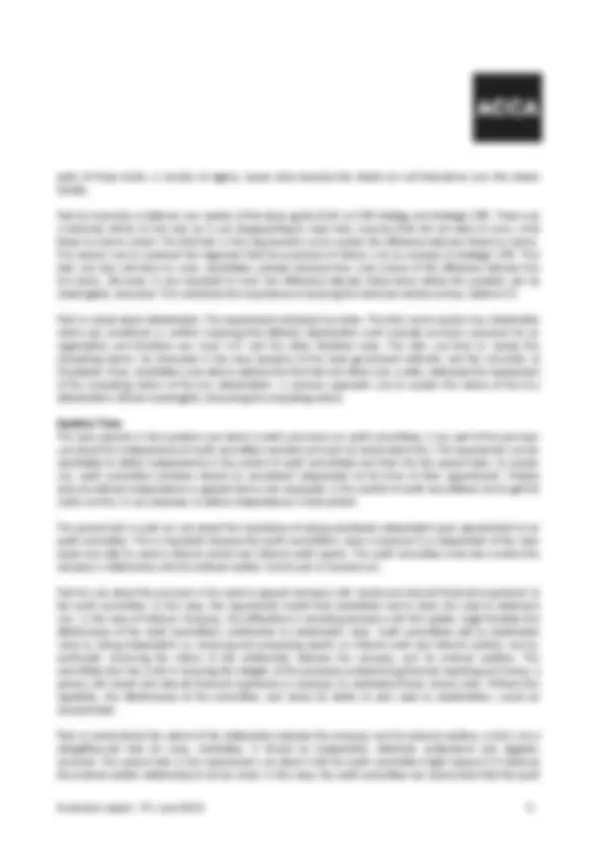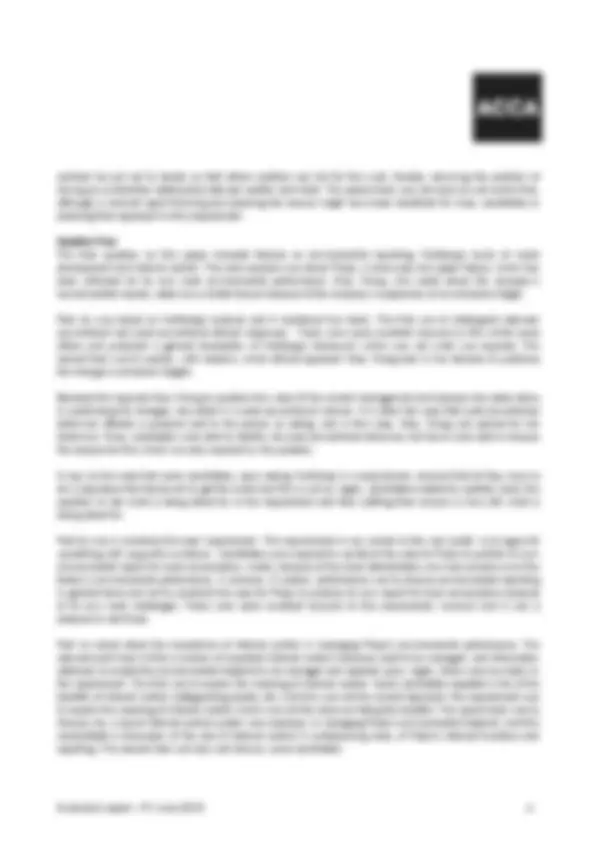




Study with the several resources on Docsity

Earn points by helping other students or get them with a premium plan


Prepare for your exams
Study with the several resources on Docsity

Earn points to download
Earn points by helping other students or get them with a premium plan
Community
Ask the community for help and clear up your study doubts
Discover the best universities in your country according to Docsity users
Free resources
Download our free guides on studying techniques, anxiety management strategies, and thesis advice from Docsity tutors
An examiner's report for the p1 governance, risk & ethics exam held in june 2015. The report provides general comments on the overall performance of the candidates, discusses specific questions and answers, and offers suggestions for improvement. It covers topics such as governance in family-owned vs. Public listed companies, ethical dilemmas, risk management, and internal control.
What you will learn
Typology: Lecture notes
1 / 4

This page cannot be seen from the preview
Don't miss anything!



In keeping with the usual rubric for P1 papers, there was a compulsory section A question worth 50 marks (which was compulsory) and this was followed by a choice of two from three 25 marks questions in section B of the paper. The overall performance in the June diet was similar to previous diets and as always, I would like to congratulate successful candidates and their tutors on an excellent achievement.
In general terms, we would repeat some of the points made in previous examiner’s reports. Firstly, obey the verb. If the verb in the question says ‘explain’ then a definition is insufficient. If it says ‘criticise’ then an explanation is insufficient. This is very important, especially at the professional papers stage of ACCA’s qualification. Second, it is often necessary to study the information in the case to fully answer a requirement. If this is the case, then a bookwork-type is insufficient and those candidates who take that approach are unlikely to be well-rewarded in terms of marks. Third, time needs to be tightly budgeted. There is sometimes a temptation to spend more time answering the requirements that candidates are happier with but most candidates need to answer all of the questions on the paper to receive a passing mark and omitting questions because of poor time budgeting.
Question One The case scenario in question 1 was about a company called Lysus, which made surgical joints. The case describes a situation in which inferior material was used in the manufacture of these joints with some very unfortunate consequences for patients. The requirements were based around some of the regulatory and ethical issues associated with this action. The company’s owner, Simon Mara, substituted regulated material for inferior material and the result was that the replacement joints sometimes failed, resulting in some very unfortunate injuries in patients.
Part (a) was worth ten marks and required candidates to distinguish between the governance of a family-owned company and a public listed company. Most candidates were able to do this to some extent but the second task in the question was less well answered by many. It asked candidates to explain how Mr Mara may not have committed the offences he did had Lysus been a public company. This required candidates to discuss the regulation of public companies (under listing rules in a principles-based jurisdiction). This included challenging the ‘tight-knit’ culture of a family business, the lack of accounting to shareholders, the lack of regulation over family businesses, lack on external scrutiny and expertise, etc. This second task was much less well answered by many candidates, perhaps because it required candidates to apply theory to a real situation, and this seems to have been a challenge to some.
Part (b) asked candidates to criticise Amy Tsang. She was the accountant who was bullied by Mr Mara into helping to facilitate the employment of the inferior materials. In taking part in the bad practice, she also acted against the public interest. In answering this requirement, some candidates based their answers on the fundamental principles of professionalism. By discussing these principles (integrity, objectivity, professional competence an due care, confidentiality and professional behaviour), answers might have covered some of the criticisms of Amy’s behaviour but this was not the correct approach. The correct approach was to review the case, and then discuss the criticisms of her behaviour in terms of one issue and then the next. The use of ‘lists’ are rarely a good approach and candidates would have been better studying the case and discussing her behaviour on a point-by-point basis.
Part (c) contained two tasks: to explain why some risks vary by industry sector (which was largely bookwork) and then, in the context of the case, to discuss why legal risk is a more relevant risk in the surgical supplies industry. The first part was done better than the second part over all. Many candidates were able to explain by risks vary by sector, often in terms of changing business models, different environments, different activities with different
risk exposures, etc. It was frustrating that candidates were not able to attract marks on the second task, however, because it wasn’t a particularly ambitious requirement. Whenever something as important (to patients) as surgical implants like joint replacements is concerned, anything that goes wrong with the device as a result of poor manufacturing (as was the case at Lysus), then legal risk becomes important because of patients pursuing legal remedies against the company.
Part (d) was to be written in the form of an article for the investors’ magazine Investors in companies. This approach has been used before in P1 papers so well-prepared candidates would have studied the correct approach to answering requirements of this type. There were four professional marks for answering the question in the right way. Just for the avoidance of doubt, this meant that a letter, a memo, a report or any other form of format were not correct ways of answering this requirement.
Part (d)(i) required candidates to do two things: to know about the benefits of having an effective non-executive chairman and then to apply this to the situation at Lysus. Weaker answers listed the roles of a chairman (not what was required) whilst the best answers looked at the case of Mr Mara and his deceit, and considered how a strong and effective non-executive chairman would have helped to prevent this happening on the first place. This was one of the reasons why the Cadbury committee in the UK (in 1992) recommended the separation of these two roles after the Maxwell Mirror Group newspapers pension value theft by Mr Maxwell in the United Kingdom. The case of Lysus, in a different way, represents a similar abuse of executive power.
It was frustrating to see some answers introduce the four roles of non-executive directors (people, risk, strategy and scrutiny) as this was clearly not the approach to the requirement. Perhaps some candidates, on seeing the word ‘non-executive’, assume the roles is the answer to the question. Not so in this case. It is always important to work out what the requirement is asking for and carefully responding to the requirement on a task-by-task basis.
Part (d)(ii) was about embedding risk into Lysus’s operations. The question specifically mentioned probity risk, which is the risk of management action that fails to take into account the need for integrity and the highest standards of ethical behaviour. The fact that Mr Mara failed against this standard makes the question all the more relevant. A common failing on this question was to define probity risk but then to only weakly explain how this might be embedded. The correct approach was to stop and think about how this risk might be embedded. I suspect a short time planning the answer would have been a beneficial approach for those who rushed or missed out the second task in this requirement.
Question Two The case in question 2 was about Rosey and Atkins (R&A), which was based on a real life investment company based in Europe. Its strategy was to invest in many of the country’s largest companies and it had over two million clients who invested in the funds managed by Rosey and Atkins. The case explains how the company invested in Natcon, a national house builder, in order to build affordable homes in certain locations. The case goes on to explain how Natcon bought land near the University of Housteads and that this had given rise to some debate about the use of the land.
Part (a) asked candidates to do two tasks. The first was to distinguish between private and institutional shareholders and many candidates made a good attempt at this. The second, slightly more ambitious task was to discuss the agency problems brought about by R&A holding investments on behalf of clients. A typical weak approach was to define agency but this was not what was required. Because R&A holds funds and clients buy
contract be put out to tender so that others auditors can bid for the work, thereby removing the problem of having an overfamiliar relationship between auditor and client. The second task was not done as well as the first, although a moment spent thinking and planning the answer might have been beneficial for many candidates in planning their approach to this requirement.
Question Four The final question on this paper included themes on environmental reporting, Kohlberg’s levels of moral development and internal control. The case scenario was about Pulpo, a local pulp and paper factory which has been criticised for its own local environmental performance. Mary Wong, who cared about the company’s environmental impact, acted as a whistle blower because of the company’s suspension of an emissions target.
Part (a) was based on Kohlberg’s analysis and it contained two tasks. The first was to distinguish between conventional and post-conventional ethical responses. There were some excellent answers to this whilst some others just produced a general description of Kohlberg’s framework which was not what was required. The second task was to explain, with reasons, which ethical approach Mary Wong took in her decision to publicise the change in emissions targets.
Because this required Mary Wong to question the value of the current management and because she acted alone in publicising the changes, she acted in a post-conventional manner. It is often the case that post-conventional behaviour attracts a personal cost to the person so acting, and in this case, Mary Wong was sacked for her behaviour. Many candidates were able to identify her post-conventional behaviour but fewer were able to discuss the reasons for this which was also required by the question.
It may be the case that some candidates, upon seeing ‘Kohlberg’ in a requirement, assume that all they have to do is reproduce the framework to get the marks but this is not so. Again, candidates needed to carefully study the question to see what is being asked for in the requirement and then crafting their answer in line with what is being asked for.
environmental report for local consumption, mainly because of the local stakeholders who had concerns over the factory’s environmental performance. A common, if weaker, performance was to discuss environmental reporting in general terms but not to construct the case for Pulpo to produce its own report for local consumption because of its own local challenges. There were some excellent answers to this requirement, however and it was a pleasure to see those.
Part (c) asked about the importance of internal control in managing Pulpo’s environmental performance. The relevant point here is that a number of important internal control measures need to be managed, and information obtained, to enable the environmental footprint to be managed and reported upon. Again, there were two tasks in the requirement. The first was to explain the meaning of internal control. Some candidates repeated a list of the benefits of internal control (safeguarding assets, etc.) but this was not the correct approach: the requirement was to explain the meaning of internal control which was not the same as listing the benefits. The second task was to discuss why a sound internal control system was necessary in managing Pulpo’s environmental footprint, and this necessitated a discussion of the role of internal control in underpinning many of Pulpo’s internal functions and reporting. This second task was less well done by some candidates.